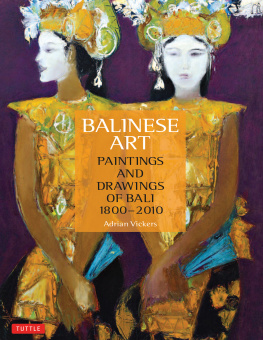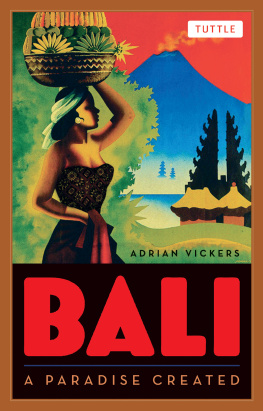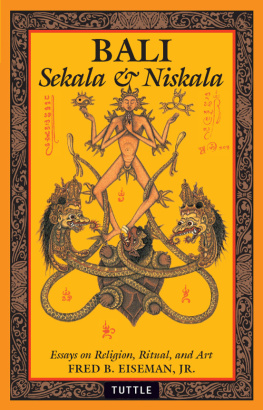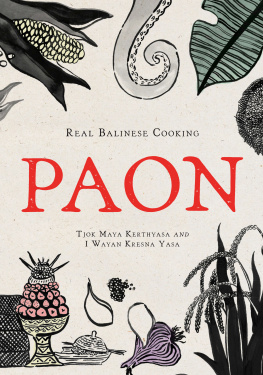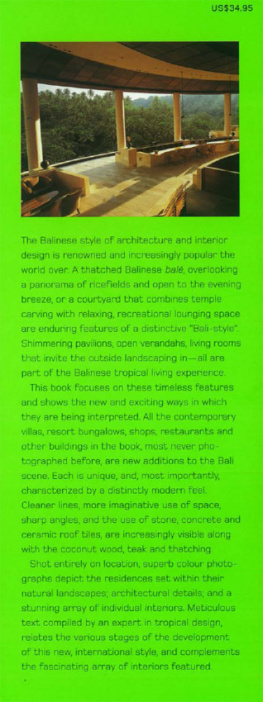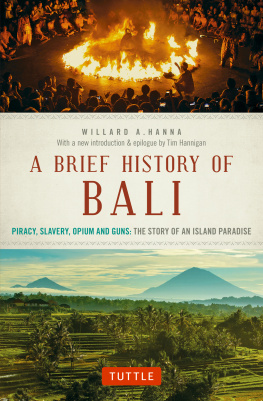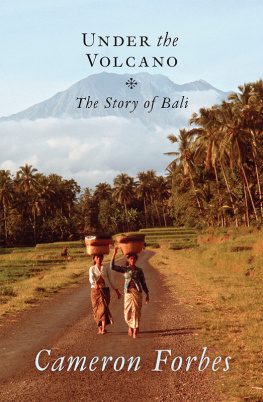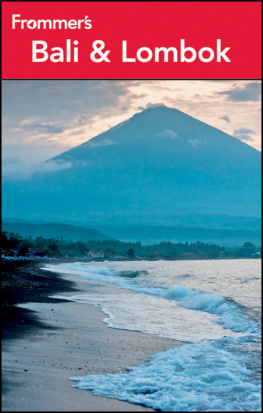Adrian Vickers - Balinese Art: Paintings and Drawings of Bali 1800–2010
Here you can read online Adrian Vickers - Balinese Art: Paintings and Drawings of Bali 1800–2010 full text of the book (entire story) in english for free. Download pdf and epub, get meaning, cover and reviews about this ebook. year: 2012, publisher: Tuttle Publishing, genre: Children. Description of the work, (preface) as well as reviews are available. Best literature library LitArk.com created for fans of good reading and offers a wide selection of genres:
Romance novel
Science fiction
Adventure
Detective
Science
History
Home and family
Prose
Art
Politics
Computer
Non-fiction
Religion
Business
Children
Humor
Choose a favorite category and find really read worthwhile books. Enjoy immersion in the world of imagination, feel the emotions of the characters or learn something new for yourself, make an fascinating discovery.
- Book:Balinese Art: Paintings and Drawings of Bali 1800–2010
- Author:
- Publisher:Tuttle Publishing
- Genre:
- Year:2012
- Rating:4 / 5
- Favourites:Add to favourites
- Your mark:
- 80
- 1
- 2
- 3
- 4
- 5
Balinese Art: Paintings and Drawings of Bali 1800–2010: summary, description and annotation
We offer to read an annotation, description, summary or preface (depends on what the author of the book "Balinese Art: Paintings and Drawings of Bali 1800–2010" wrote himself). If you haven't found the necessary information about the book — write in the comments, we will try to find it.
Balinese Art: Paintings and Drawings of Bali 1800–2010 — read online for free the complete book (whole text) full work
Below is the text of the book, divided by pages. System saving the place of the last page read, allows you to conveniently read the book "Balinese Art: Paintings and Drawings of Bali 1800–2010" online for free, without having to search again every time where you left off. Put a bookmark, and you can go to the page where you finished reading at any time.
Font size:
Interval:
Bookmark:


T wo examples from works by leading painters from Bali at the turn of the twenty-first century help viewers unfamiliar with this art to understand the principles from which painters work, how the formal and narrative elements come together to amaze the senses of their audiences. The first example is the leading Indonesian contemporary painter I Nyoman Masriadi (1973), whose works are bizarre and confronting, cartoon-like reflections on human nature and society. The second is an artist more senior by thirty-three years, I Nyoman Mandra (1946), whose works are the acme of refinement, and whose village lifestyle is far removed from the modern urban and cosmopolitan world in which Masriadi works ( Fig. 1 ) .
Southeast Asias most expensive contemporary painter, Bali-born Nyoman Masriadi, challenges his viewers with striking figurative works. These images have a strong linearity and sense of proportion that is quite alien to Western traditions of perspective. They draw on the story-telling and the two-dimensional format of the famous shadow puppet ( wayang ) tradition. The figures, rendered like stiff icons, typify the rougher aspect of Balinese painting. In works such as his Awakening Kumbakarna , Masriadi demonstrates his connections to the foundations of Balinese painting in narrative, in this case specifically to the ancient Hindu epic, the Ramayana , in which the demon Kumbakarna is the last great weapon to use against the hero, Rama ( Fig. 3 ) . Produced in 1999 after Indonesias most important awakening in Masriadis life, the fall of the dictator Suharto, the work gives a contemporary context to mythology, something most Balinese artists do. This painting is ambiguous, since Kumbakarna is a demon to be fought off, and the democratic reawakening of the nation in 1998 also awoke demons of violence and destruction.

Fig. 1 I Nyoman Mandra, 2009 (photo Gustra).
Masriadis works impress us with their combinations of line, flatness and dense narrative. The purest expressions of these artistic foundations are still practised in the village of Kamasan, in Klungkung, southeast Bali. The art of Kamasan is regarded not just as the high point of tradition but also as the epitome of the classical form of Balinese painting that connects directly to the wayang or shadow puppet theatre. Today, one artist stands out as an advocate of that tradition. I Nyoman Mandra is acknowledged throughout Indonesia as the master painter and teacher of Kamasan painting. Mandras work is a demonstration of how artistic accomplishment is the product of long craft training.
Mandras painting of the semi-divine bird Garuda from the Hindu Mahabharata epic, exemplifies the classic form ( Fig. 2 ) . The figures are directly based on shadow puppets, displaying a different type of conflict, one between the central figure of the anthropomorphic Garuda eagle and the gods of the directions. This is a conflict to obtain the divine liquid of immortality, and thus the scene mirrors aspects of Balinese ceremonies in which holy water occupies a central position.
While Balinese paintings are nowadays found primarily in galleries and museums, traditional works were originally placed in temples and palaces. Mandras village of Kamasan is one of the few villages that still brings out paintings for temple festivals, to hang around the eaves of pavilions or on backing boards of offering places. This ceremonial context tells us something about the religious basis of Balinese art. Paintings are meant to convey meanings that bridge communication between the material world humans inhabit and the immaterial world of divine and demonic forces.
Balinese painters often have experience in the other arts. For example, Nyoman Mandra is also a musician in the refined Semar Pagulingan musical ensemble of his village. In the past, Kamasan village had as many as twelve puppeteers in residence. Other painters are also sculptors. This practical interrelationship between the arts means that each draws on the otherpaintings have aspects of performanceand that the sense of plastic form realized in sculpture carries over into the two-dimensional arts. This interdependence of art forms allows us to talk about generalized Balinese aesthetic principles, even though each form has unique elements, and there is astonishing variation between villages and areas in each of the arts.

Fig. 2 I Nyoman Mandra, Kamasan, Garuda Nawasanga , Garuda and the Gods of the Directions . Garuda fights the gods as he claims the elixir of life: North (top): Wisnu with his weapon, the cakra or discus; Northwest (clockwise, to the right of Wisnu): Sangkara, angkus or elephant goad; West: Mahadewa, nagapasa or snake arrow; Southwest: Rudra, moksala or mace; South: Brahma, danda or club; Southeast: Maheswara, dupa or fire weapon; East: Iswara, bajra or thunderbolt weapon; Northeast: Sambu, trisula or trident (arrow), 1993, natural paint on cotton, 252 x 227 cm, Gunarsa Museum, USA (photo Gustra).
The painting tradition has a repertoire of images and forms that are integral to even the most contemporary works of art, but while many contemporary works have a universal audience, there are other aspects of Balinese painting that remain strange and inaccessible to outside viewers. What do such viewers need to know in order to appreciate Balinese works?

Fig. 3 I Nyoman Masriadi, Yogyakarta, Awakening Kumbakarna , 1999, acrylic on canvas, 140 x 200 cm, OHD Museum Collection, Magelang (photo Gajah Gallery).
Balinese Aesthetics
The exquisite flow of line and pure, flat figuration in Mandras work is the key to the sense of beauty that Balinese appreciate in painting. Part of that beauty, the way a painting can move the viewer, comes from a canon of proportions and forms. Tradition, however, does not mean absence of change, and individual expression comes from the manipulation of pre-set forms. These are the starting points for understanding Balinese taste.
A revealing commentary on Mandras art comes from a fellow Balinese painter. Pioneer of Balinese modernist art, I Nyoman Gunarsa (1944) is himself a painter of figures derived from the shadow theatre, but in an abstracted, painterly style. He describes Mandras accomplishments as a combination of adherence to the rules of the style, with ultimate expressive facility. Gunarsa is saying that what looks to outsiders like conventional work is the realization of set forms and technical problems. Mandra goes through stages that must be followed in a set manner, in order to gain the maximum classic result.
Gunarsa observes that Mandras control is also over the form of the proportions of the figures, the iconography, the facial features or character of the refined, coarse, demonic and monster figures. This attention to proportion and iconographic convention involves the differing symbolic uses of colours for some characters, such as red, yellow and blue, that each have their own meanings; the symbolic hand gestures (or mudra ) of each figure, as well as the foot movements, body stances.... In making a figure, he has to demonstrate control over all the elements of the shadow puppet ( wayang ) theatre form. Mandras control of the ideal wayang proportions includes his overall framing outlines which are then refined with precision and attention to detail.
Font size:
Interval:
Bookmark:
Similar books «Balinese Art: Paintings and Drawings of Bali 1800–2010»
Look at similar books to Balinese Art: Paintings and Drawings of Bali 1800–2010. We have selected literature similar in name and meaning in the hope of providing readers with more options to find new, interesting, not yet read works.
Discussion, reviews of the book Balinese Art: Paintings and Drawings of Bali 1800–2010 and just readers' own opinions. Leave your comments, write what you think about the work, its meaning or the main characters. Specify what exactly you liked and what you didn't like, and why you think so.

